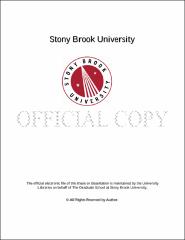| dc.identifier.uri | http://hdl.handle.net/11401/77510 | |
| dc.description.sponsorship | This work is sponsored by the Stony Brook University Graduate School in compliance with the requirements for completion of degree. | en_US |
| dc.format | Monograph | |
| dc.format.medium | Electronic Resource | en_US |
| dc.language.iso | en_US | |
| dc.publisher | The Graduate School, Stony Brook University: Stony Brook, NY. | |
| dc.type | Dissertation | |
| dcterms.abstract | Proteins from the same family often share many structural and functional motifs. Variations in primary structure, however, allow a single protein family to modulate a broad range of biological processes. Several methods can be used to identify sequence conservation, but complementary mutagenesis experiments are often needed to understand the multiple roles that a given amino acid may have in maintaining overall fitness. Limitations related to financial and temporal costs generally constrain these experiments to smaller proteins or peptides, or to only partial sampling of sequence spaces, and we have devised a computational protocol for large-scale mutagenesis to circumvent these obstacles using a G-protein heterotrimer as a model system. The dead-end elimination and A* search (DEE/A*) algorithms are typically used to find a small number of sequences that may enhance the current level of fitness or introduce novel functions into a protein. These algorithms were adapted to find all low-energy sequences and their corresponding structures, allowing us to disentangle protein fitness, defined here as a combination of structural stability and binding interactions. We demonstrate the effectiveness of DEE/A* in capturing the biophysical features of amino-acid substitutions, and in quantifying the extent that individual positions are affected by mutagenesis, based on all low-energy single mutants. A modified version of this protocol was also used to explore double and triple mutants in the context of the β subunit in the G-protein heterotrimer, a representative repeat protein from the β -propeller family. Repeat proteins are subject to the same experimental challenges as non-repeating ones, but with the addition of having to properly define corresponding repeats in primary structure; DEE/A* is leveraged here to identify patterns of important interaction using a structure-based approach, and reveal a deeply connected interaction motif. | |
| dcterms.available | 2017-09-20T16:52:50Z | |
| dcterms.contributor | MacCarthy, Thomas | en_US |
| dcterms.contributor | Green, David F | en_US |
| dcterms.contributor | Glynn, Steven. | en_US |
| dcterms.contributor | Rizzo, Robert C | en_US |
| dcterms.creator | Au, Loretta | |
| dcterms.dateAccepted | 2017-09-20T16:52:50Z | |
| dcterms.dateSubmitted | 2017-09-20T16:52:50Z | |
| dcterms.description | Department of Applied Mathematics and Statistics. | en_US |
| dcterms.extent | 153 pg. | en_US |
| dcterms.format | Monograph | |
| dcterms.format | Application/PDF | en_US |
| dcterms.identifier | http://hdl.handle.net/11401/77510 | |
| dcterms.issued | 2015-08-01 | |
| dcterms.language | en_US | |
| dcterms.provenance | Made available in DSpace on 2017-09-20T16:52:50Z (GMT). No. of bitstreams: 1
Au_grad.sunysb_0771E_12009.pdf: 18928042 bytes, checksum: dca7dc9c395740dd6ab981176165518c (MD5)
Previous issue date: 2014 | en |
| dcterms.publisher | The Graduate School, Stony Brook University: Stony Brook, NY. | |
| dcterms.subject | Applied mathematics | |
| dcterms.subject | computational chemistry, large-scale mutagenesis, protein evolvability | |
| dcterms.title | Quantitative approaches for deconvolving the multiple contributions of primary structure to protein fitness | |
| dcterms.type | Dissertation | |

